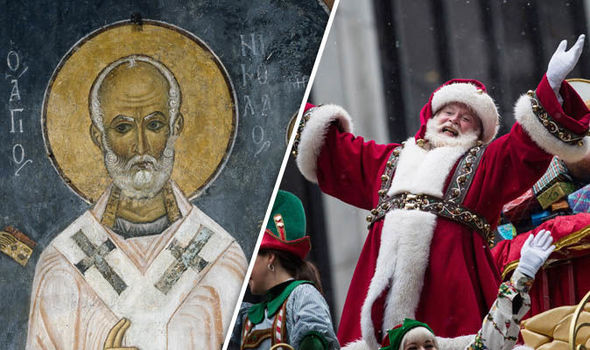The Origin of Santa Claus

December 17, 2021
Santa Claus may just be the most well-traveled man in history, and no, I’m not referring to his annual journey to every house on Earth. Through many eras, cultures, and places, Santa Claus has been a staple of Christmas as we know it for as long as any of us can remember. But what kind of a name is Santa Claus, anyway? Why do we think of him as a jolly fat man in a red suit? And how long ago did we start venerating this man whom no one has seen?
The legend of Santa Claus begins in the third century A.D. in Patara, what is now Turkey. St. Nicholas, a name which we commonly associate with our perception of Santa Claus, was born to wealthy parents who would be killed by an epidemic when he was still a boy. Although they did not raise him for long, his parents raised him to be a devout Christian, so with his newfound inheritance, he dedicated himself to helping the sick, needy, and dying. After becoming famous for his generosity, Nicholas was made Bishop of Myra. One legend of St. Nicholas details how he saved three sisters from human trafficking by paying their dowries so that they could be married and not sold. St. Nicholas would be canonized by Pope Eugene IV on June 5, 1446.
Like Cholera, Albert Einstein, and the real Chef Boyardee (stories for another time), the legend of St. Nicholas found its way into the U.S. by way of New York. By the late 18th century, a large Dutch population had amassed in the Empire State, carrying with it many traditions and cultural hallmarks. Among them was the commemoration of the death of Saint Nicholas. How do you say “Saint Nicholas” in Dutch? Great question, I’m glad you asked: Sint Nikolaas. This Dutch pronunciation quickly transformed via the mystery that is slang, and soon became “Sinter Klaas”, for short. The name caught on quickly, and once again changed, becoming the “Santa Claus” of which we have all spoken.
While Santa’s name was quickly taking shape, our image of the jolly fat man in a red suit still had a ways to go. Sinter Klaas was described as a “rascal” with a blue three-cornered hat, red waistcoat, and yellow stockings. This perception changed in 1822, with a poem still drawn-from in popular culture today. Clement Clarke Moore composed “An Account of a Visit from St. Nicholas” with the intention of entertaining his three daughters. Due to his audience and scope, one can see why his title doesn’t quite roll off the tongue. Subsequently, the poem became known as “‘Twas the Night Before Christmas”. In the poem, St. Nicholas is portrayed as our modern notion of Santa Claus. He is described as:
- Coming down the chimney
- Dressed in fur
- Carrying a bundle of toys on his back
- Having a beard “as white as snow”
- Having a “little round belly… like a bowl full of jelly”
- Filling children’s stockings
The list goes on and on. So, combining the newfound name of “Santa Claus” and Moore’s portrayal of St. Nicholas, America permanently adopted the legend of the jolly fat man whom we all know and love. Each part of the world has witnessed its own Christmas evolution: Christkind delivers presents to well-behaved Swiss and German children. Jultomten rides his goat-drawn sleigh to do the same in Scandinavia. Pere Noel (Father Christmas) fills the shoes of Children in France, and the witch La Befana rides her broom down Italian chimneys to deliver her gifts. But this is America, where our Christmas hero (besides Jesus) is a fat man with a Dutch name. This man has empowered us to be not only the Land of the Free and the Home of the Brave, but a beacon of consumerism for nations everywhere. So as you stay at home and open presents, say a quick thanks to St. Nicholas of Myra, 18th-Century Dutch immigrants, and Clement Clarke Moore for building the Santa Claus whom we all celebrate.
